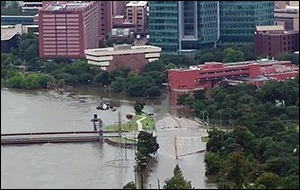Courtesy of Pam Martens
According to insurance experts, approximately 80 percent of the homeowners impacted by flooding in Houston may not have flood insurance policies on their home. That’s because much of Houston falls outside of designated Special Flood Hazard Zones where mortgage holders are required to maintain flood insurance policies.
Hoping to relieve some of the panic by homeowners rescued from water-logged homes in Texas who have no idea when they may be able to return to their home or where the money will come from to restore the home to livability, the Federal Emergency Management Agency (FEMA) has released a fact sheet on what types of disaster assistance it can make directly to individuals along with specifics on how to apply.
The fact sheet makes clear that not all individuals are being guaranteed each form of assistance. It notes that the assistance “can include as required” the following.
- Rental payments for temporary housing for those whose homes are unlivable. Initial assistance may be provided for up to three months for homeowners and at least one month for renters. Assistance may be extended if requested after the initial period based on a review of individual applicant requirements.
- Grants for home repairs and replacement of essential household items not covered by insurance to make damaged dwellings safe, sanitary and functional.
- Grants to replace personal property and help meet medical, dental, funeral, transportation and other serious disaster-related needs not covered by insurance or other federal, state and charitable aid programs. (FEMA funded at 75 percent of total eligible costs; 25 percent funded by the state.)
- Low-interest loans to cover residential losses not fully compensated by insurance. Loans available up to $200,000 for primary residence; $40,000 for personal property, including renter losses. Loans available up to $2 million for business property losses not fully compensated by insurance.
- Loans up to $2 million for small businesses, small agricultural cooperatives and most private, non-profit organizations of all sizes that have suffered disaster-related cash flow problems and need funds for working capital to recover from the disaster’s adverse economic impact. This loan in combination with a property loss loan cannot exceed a total of $2 million.
- Loans up to $500,000 for farmers, ranchers and aquaculture operators to cover production and property losses, excluding primary residence.
- Other relief programs: Crisis counseling for those traumatized by the disaster; income tax assistance for filing casualty losses; advisory assistance for legal, veterans’ benefits and social security matters.
To apply for assistance, individuals and business owners in the designated counties can register online at www.DisasterAssistance.gov or call 1-800-621-FEMA (3362). Disaster assistance applicants, who have a speech disability or hearing loss and use TTY, should call 1-800-462-7585 directly; for those who use 711 or Video Relay Service (VRS), call 1-800-621-3362. FEMA indicates that the toll-free telephone numbers are currently operating from 7 a.m. to 10 p.m. (Texas time) seven days a week.
The Small Business Administration (SBA), another Federal program, has also posted specifics on the financial relief it can bring to small businesses that have been impacted by Hurricane Harvey. It lists the following forms of relief that could be available:
- Business Loans – The law limits business loans to $2,000,000 for the repair or replacement of real estate, inventories, machinery, equipment and all other physical losses. Subject to this maximum, loan amounts cannot exceed the verified uninsured disaster loss.
- Economic Injury Disaster Loans (EIDL) – The law limits EIDLs to $2,000,000 for alleviating economic injury caused by the disaster. The actual amount of each loan is limited to the economic injury determined by SBA, less business interruption insurance and other recoveries up to the administrative lending limit. EIDL assistance is available only to entities and their owners who cannot provide for their own recovery from non-government sources, as determined by the U.S. Small Business Administration.
- Business Loan Ceiling – The $2,000,000 statutory limit for business loans applies to the combination of physical, economic injury, mitigation and refinancing, and applies to all disaster loans to a business and its affiliates for each disaster. If a business is a major source of employment, SBA has the authority to waive the $2,000,000 statutory limit.
- Home Loans – SBA regulations limit home loans to $200,000 for the repair or replacement of real estate and $40,000 to repair or replace personal property. Subject to these maximums, loan amounts cannot exceed the verified uninsured disaster loss.
…




